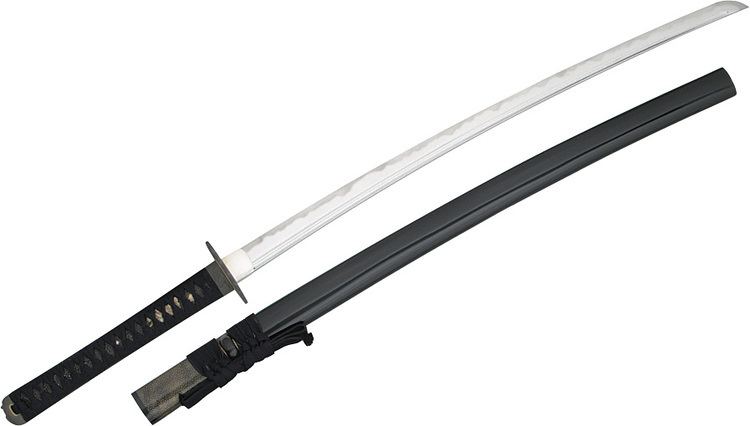 | ||
Iaitō (居合刀) is a modern metal practice sword, without a cutting edge, used primarily for practicing iaido.
Contents
Other Japanese swords
A real (sharp) katana is called a shinken (真剣?, lit., real sword). In contrast to shinken, iaitō have no cutting edge and are designed for iai/battō practice and are usually unsuited for sword-to-sword contact. These should not be confused with other fake swords, which are primarily made for decorative reasons and generally unsafe for martial arts practice.
Materials and manufacture
Most iaitō are made of an aluminium-zinc alloy which is cheaper and lighter than steel. This use of alloy and a blunt edge also avoids the Japanese legal restrictions on the manufacture of swords made of ferrous metals. As such, Japanese-made iaitō are intended as practice weapons and are not suited for any type of contact. The best alloy blades are rather faithful reproductions of real swords with authentic weight and shape along with similarly high-quality finish and fittings. Iaitō may even have a mock hamon (刃文?, lit., blade pattern, the temper line of a tempered steel blade). The average weight for a real uchigatana (打刀) is typically 1,200 g without the scabbard while a typical alloy iaitō is roughly 820 g. Some steel iaitō are also constructed and can weigh around 900–950 g for a 74 cm blade.
Some imitation Japanese swords are made in countries other than Japan. They may even be made of folded steel, much like a real katana, but with a blunt edge. Such weapons would face the same use and ownership restrictions in Japan as genuine swords, and would not be called iaitō in Japan.
Meirin Sangyo Company claims to be the first to manufacture an iaito. First iaito were made after the Second World War, to permit people without means to own a real sword, to have a tool for their practice of modern budo. Many swordsmiths located in Seki, Gifu Prefecture, also produce iaitō.
Some dōjō in Japan recommend that only alloy blades be used for practicing iaidō until the practitioner’s skill is consistent enough to safely use a sharp-edged sword, Some iaidō schools may require a practitioner to start with a shinken right away, while other schools prohibit the use of a shinken altogether.
The matching of iaitō length, weight, and balance to the practitioner’s build and strength is of utmost importance to safely and correctly perform the iaidō forms (kata). Due to the repetition involved in the practicing of iaidō, iaitō are often constructed with the balance point of the blade being set farther from the blade’s point (kissaki) and closer to the guard (tsuba) than other blades.
